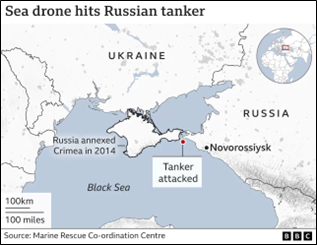ACADEMY SITREP – Ukraine Attacks Russian Tanker with Sea Drone
August 6, 2023

What has Happened: On Saturday, a Russian tanker was hit by a Ukrainian sea drone in the Kerch Strait. In addition, on Friday, Ukraine attacked a Russian naval ship with a sea drone in the Black Sea port of Novorossiysk. Kiev recently said that it had designated six Black Sea ports as being in “war risk” areas, indicating that there could be further attacks on Russian territory. Ukraine’s goal in attacking the tanker was to increase insurance costs for Russia’s partners that are buying oil and shipping it out of those ports, which raises the true cost of buying “discounted” ... ACADEMY SITREP – Ukraine Attacks Russian Tanker with Sea Drone


